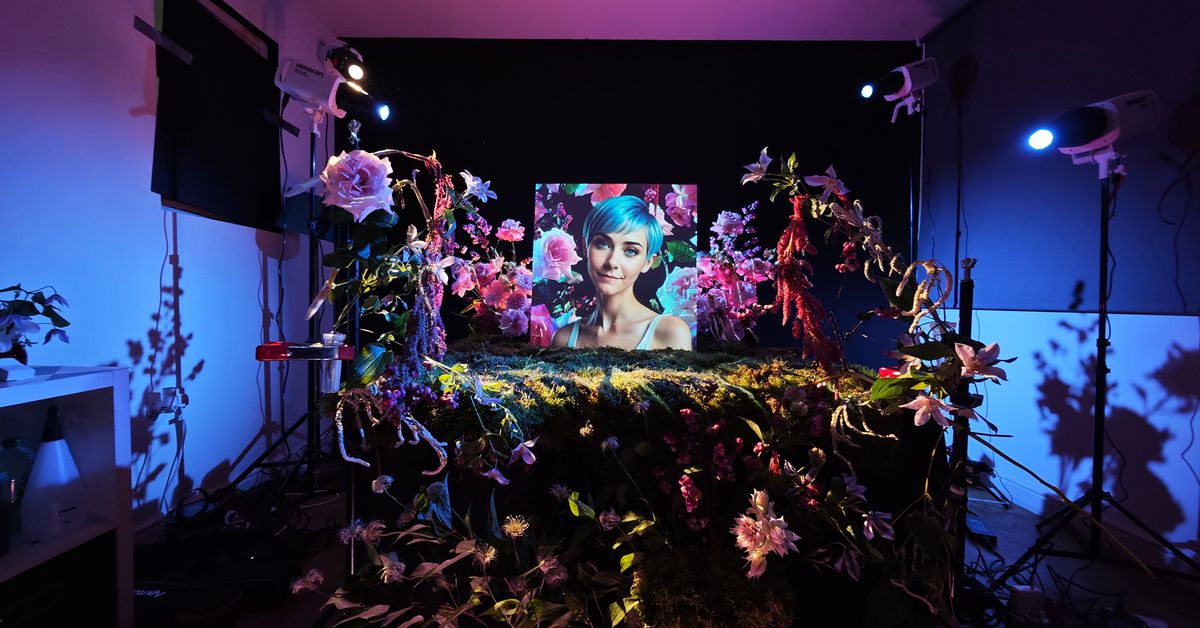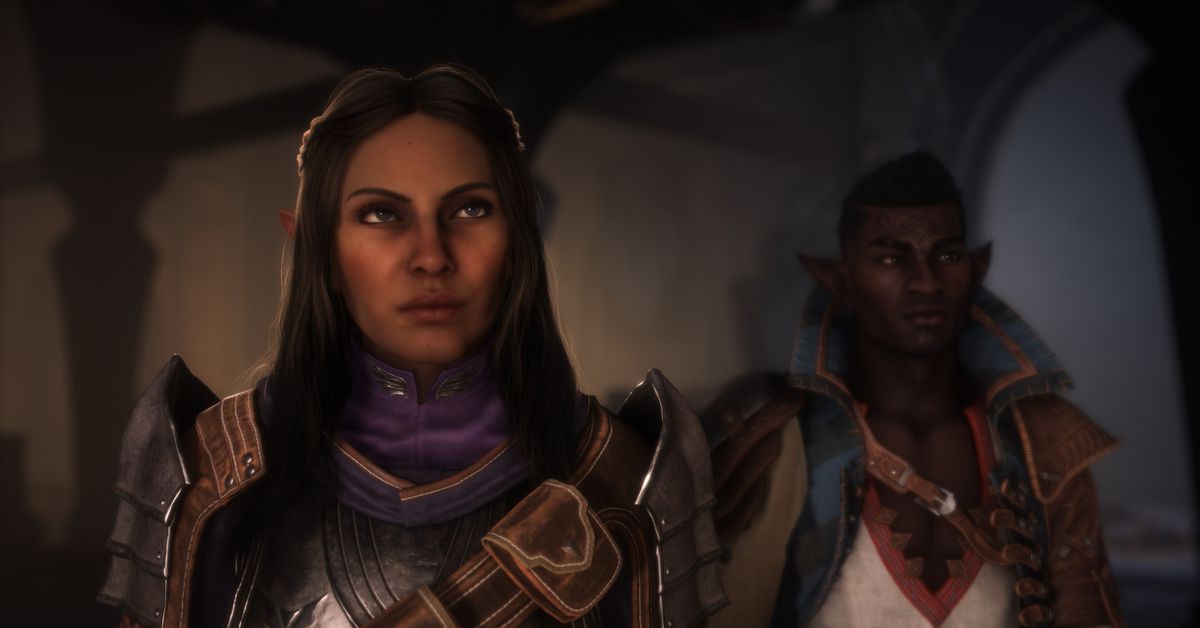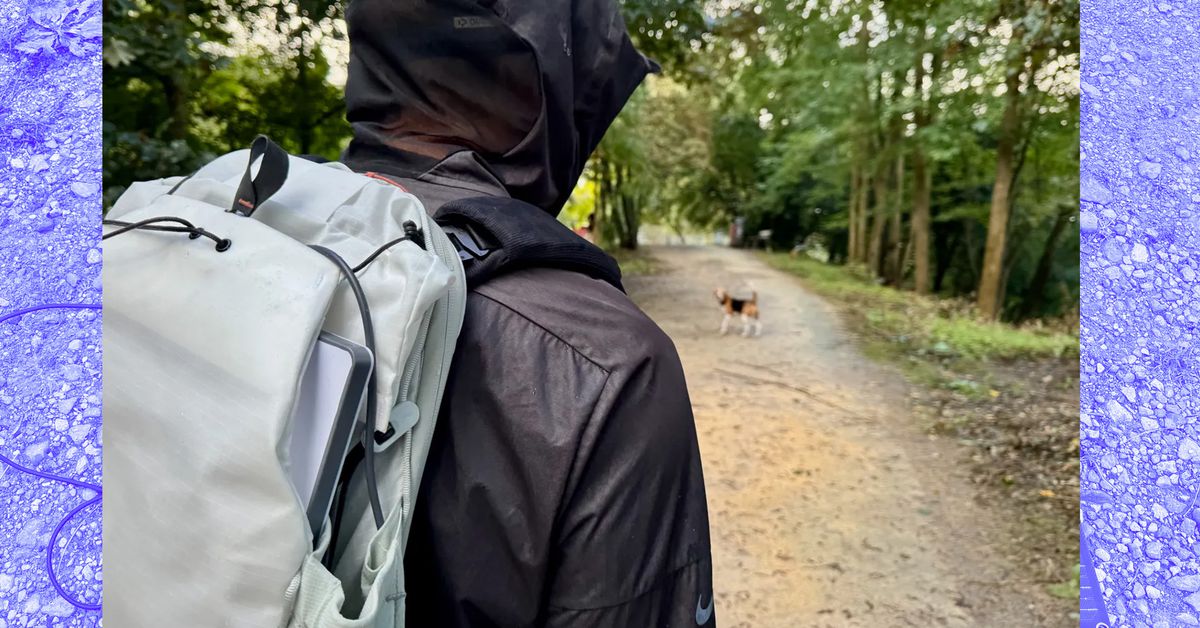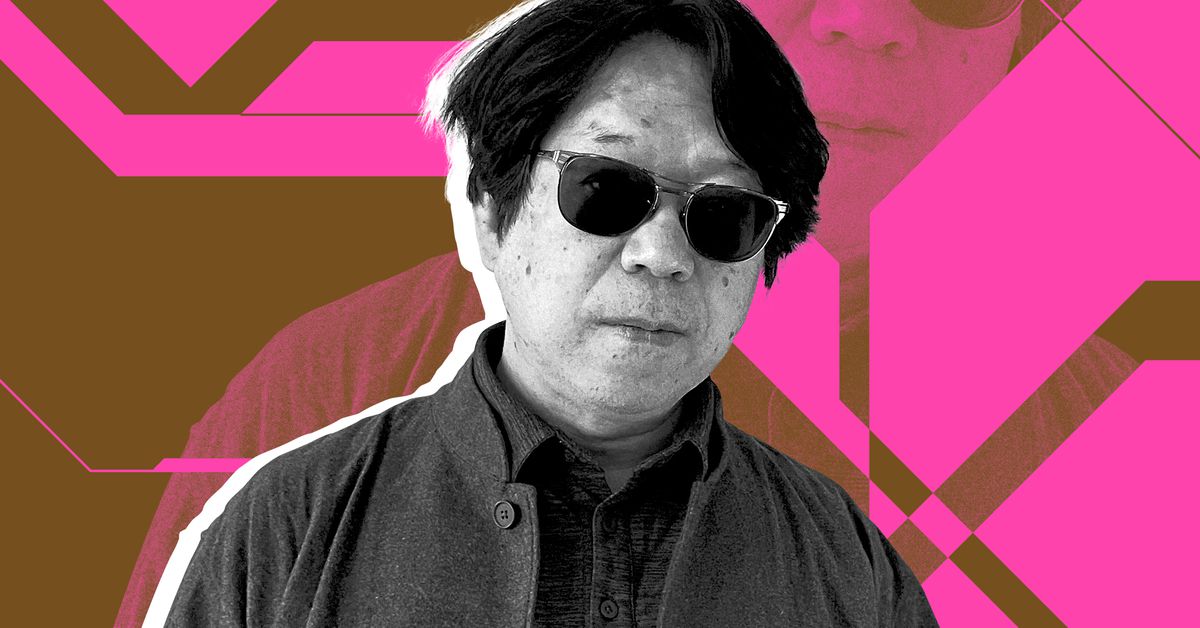Stormy Pyeatte is a UK-based video and photo artist who works with practical effects and projection mapping. The design team here at The Verge worked with her to create the evocative visuals in “Friend or Faux?” — a story layered with ethical and philosophical questions about the newly unfolding relationships some people have with AI chatbots.
I stumbled upon Pyeatte’s work on Instagram one day when I was scrolling mindlessly through the feed — and it stopped me in my tracks. Because the tech we report on is always changing, I am constantly on the lookout for innovative ways of creating visuals for our site. I was blown away by how otherworldly her work is. Through stunning set design, ethereal lighting setups, and dreamlike projection mapping, it has been a thrill to be handed such mesmerizing (and unsettling) visual solutions. Much like the AI tech at the focus of the piece, the videos draw the viewer in with a lilting mystique, while also suggesting the very human complexity inherent in this fascinating story.
This interview has been edited for length and clarity.
How did you get started working with floral photography and projection mapping?
I first became interested in projection in 2013 during college when I interned with Daniel Brodie, a projection designer on the Broadway production of Motown: The Musical. It was such a fantastic experience seeing how projections work in theater, though, back then, I didn’t have my own projector to experiment with, and it would be many, many years until I got my hands on one.
After graduating college in 2014, I found myself living in a hostel in San Francisco, working in exchange for a bed because I couldn’t afford rent. It sounds drab, but honestly, it was one of the best experiences of my life! I didn’t plan to live there. I kind of said yes to a road trip and ended up in San Francisco. Hostel life was so much fun, but I really wanted to do something creative. Luckily, Daniel introduced me to Bradley G. Munkowitz (GMUNK), who then introduced me to a few people, including an artist and friend Conor Grebel. Conor is an incredible artist, and at the time, I didn’t realize it, but he was a mentor to me. I would help out on his projects, which were all about experimenting with projection and practical effects. All of these projects were self-funded passion projects. Watching him and everyone work taught me how to embrace creating just for the joy of it.
It’s funny looking back now because I was broke and a bit aimless, but those projects — and the people who supported me — gave me so much inspiration. They would encourage me to come up with ideas and share them, though, at the time, I had few ideas or opinions of my own. They would go so far as to cover my dinners and rides back to the hostel after shoots because they knew I was a super broke recent grad artist who had something to offer but didn’t quite know what that thing was yet. That kindness and inclusion left a huge impression on me.
Around that same time, I also started working in floristry. I’d set this naive goal for myself to only make money doing “something creative,” which meant that, in reality, I was really effing broke and had to get resourceful. Growing up, I’d always loved flowers because of my mom, who was a gardener, so I figured, why not try floristry? That’s creative and that counts! So, over the next seven years, I worked in retail, luxury, and event floristry across the US, New Zealand, and Australia.
While traveling and working in floristry, I always envisioned marrying projection and floral design together, but it wasn’t until 2020 that I finally got my hands on a projector and some basic lighting gear. Once the covid-19 pandemic hit, I just threw myself into experimenting. Having the time and tools to play around was a turning point for me, and it was when I finally could play around with the things I was picturing in my head.
Photos: Stormy Pyeatte for The Verge
How did you create the visual concepts for the “Friend or Faux?” feature? What was your thought process?
After reading the draft of “Friend or Faux?” I pulled out a few themes that felt compelling to explore visually: love and adoration; intangibility and separation; fragmentation and fragility; and grief and anxiety. I then started brainstorming how each of these themes could be expressed in a visual, tangible way.
One of my biggest inspirations was thinking about the feeling you get when you’re crushing on someone so hard you can’t think straight. You’re not really seeing them clearly — you’re fixated on an idealized version of them, almost like looking through rose-tinted glasses. I wanted to bring that feeling to life by creating a surreal floral world that felt obsessive and dreamy, like you’re having “flowery tunnel vision.” It’s about being more in love with the idea of someone than with who they truly are.
For one of the images, I drew inspiration from Tracey Emin’s My Bed, her messy bed installation from the ’90s. To me, a bed is such a personal space — where you sleep but also where you lie awake, letting your thoughts and fantasies run wild. As a kid, I remember staying up late, talking to crushes on the phone, and I wanted to channel that mix of intimacy and imagination. Projecting the AI companion onto a messy bed felt like a poignant way to contrast the humanness of needing to sleep with the intangibility of the AI.
Photos: Stormy Pyeatte for The Verge
A lot of your work leans into either the artistic (and is, I assume, personally driven) or the product-based, for advertising. How has your experience working with this story been?
This is actually my first-ever editorial piece! So it was definitely a new experience for me. And yes, my work typically falls into two categories: personal and commercial.
With personal work, my goal is always to explore something new or create just for the sake of creating. I think of 80 percent of the stuff I post online as the same as sketching in a sketchbook. It’s just making something for practice or to try something new. It’s really about entertainment and experimentation — letting myself play and see where that leads or trying out a new technique or something I’m learning about.
When I’m doing product photography or videography, the focus is on storytelling through small sets and styling. I ask myself questions like, “What world does this product live in? Is it fun, surreal, or aspirational? How can I use lighting or composition to make someone think, Ooooh, ahhhh, I want to live there or smell those flowers? When working on commercial projects, I’m always thinking about the company’s ideal or existing customer. It’s often storytelling about what problem its product solves or creating an aspirational “vibe” its customer will likely identify with and creating visuals for that.
This project was different because I was thinking about the stories of the individuals featured and how this technology is impacting people on a personal level, the people close to them, and how it is likely impacting others right now. So I just naturally started slipping into thoughts about my past and reflecting on my own life and experiences, and that was my biggest inspiration.
I was thinking a lot about my early 20s, when I was dating and would have very intense and often very fleeting romances. For this project, I spent a lot of time remembering what it’s like to have a crush on someone and how intoxicating and consuming it can be. I also thought a lot about how it clouded my judgment. I remember moments when I was enamored with someone who, looking back, wasn’t actually so great. That “crushing” phase, — the obsession, the daydreaming, the inability to see things clearly — was the biggest inspiration for the visuals.
It’s funny because I’ve been with my partner for nine years now, so it’s been a long time since I’ve thought about those experiences! This project really reminded me, and I got to translate it in this cool way.
In terms of the technical side of things, not much changed. The physical building, the software, and the lighting techniques I used are the same as what I’d typically rely on. But the thought process and emotional connection behind this project were unique. It was about tapping into something more introspective and personal, rather than solving a problem or selling a product.
Photos: Stormy Pyeatte for The Verge
Can you tell us about the tech, including equipment and apps, that you used?
Before building the sets, I plan the animations I’ll need, deciding what to create in advance and what I can adjust on the fly during the shoot. For this project, we collaborated to design an AI companion featured throughout the visuals. You created the character [Note: I made a Kindroid.AI account and took many screen recordings], and I used Runway, an AI software, to bring her to life. Runway’s “image-to-video” functionality allowed me to upload the companion’s image and specify actions I wanted her to perform.
It was a tedious process, if I’m being totally honest. Like, it would be much easier and more fun to work with an actress. But we wouldn’t have gotten that “it looks human but it’s definitely not human” vibe without it. It was really cool, and I think very appropriate, to integrate AI into this project in this way. We used it to create a character that can be a visual representation of the chatbots discussed in the article. There were times when the Runway got it totally wrong, like her eyes went completely white and looked so weird in one clip, so I downloaded it and used it for one of the visuals where the idea was to convey how sometimes these chatbots totally glitch out.
Once I had the flowers from the market and allowed them time to open, I built the floral sets using standard florist tools: chicken wire; floral wire; agra wool; and my trusty secateurs. My video lighting equipment is all from Amaran, I used their 150C and 300C lights, with several different modifiers. My favorite modifier from them is the Spotlight SE. I used an Epson home / office projector for the projection mapping. I used MadMapper to map my animations and After Effects for some on-the-fly animating. For video editing, I used DaVinci Resolve.
Photos: Stormy Pyeatte for The Verge
What are your feelings about AI and what use, if any, did you make of AI tools to create the finished product?
In terms of the AI technology discussed in the article, I don’t judge what people do in their free time, but I do worry about how this technology can be used by nefarious people as a way to manipulate others and the emotionally vulnerable. The article definitely got me thinking about the anthropomorphization of technology and how it can actually be very, very dangerous. Working on this project has inspired one of my goals for 2025, which is to be more social and to get more involved in artistic communities.
I get kind of bored sitting in front of a computer all the time. I love to work with my hands and to touch and use different materials. No software — AI or otherwise — can replicate that feeling, so I will always integrate something physical into my practice.
But I see AI as a cool (and often very slow) tool that can be really beneficial. For this project, I used AI to create videos of the AI companion, combining them with footage I shot myself and using the results for projection mapping. Given the article’s subject matter, it’s an appropriate use of AI technology. I also use ChatGPT to support my writing (I once used it to create a Dungeons & Dragons campaign, which was so fun!), and I use Runway to create mock-ups of the visual ideas I see in my head. These have been game-changing for communicating and selling my ideas to clients. AI is fun. I’ll continue to use it when I find a need to.
I choose not to worry about how AI is going to impact me because a) I’m going to die one day, so I want to create and have fun while I’m here, and worrying about AI holds me back from focusing on doing creative work and b) it’s out of my control. I am choosing to focus on becoming a better creative and storyteller because that will always be useful, no matter what tools I am using.
For me, personally, if I’m buying a painting, I prefer the one painted by a human, not the one prompted by a person to be made by a machine. I really value traditional art forms and see the process of how something is made as important (maybe more) than the art itself. I see value in not just the final artwork but the entire journey that incredible artist went through to develop that thinking and skill set. It inspires me when I look at it.
With AI tech in creativity, I suspect that the people who will be the best at using AI tools are going to be people who already have rich artistic practices of their own and are well versed in art and the creative history of the past. My college professor used to say, “garbage in, garbage out.” If your script is garbage, your film will be garbage, and no amount of cutting-edge tech can save it. But if your ideas and your taste are good, it will cut through, even if the resources you have at your disposal are super minimal. AI tools are great for amplifying good ideas and supporting people with good taste — they’re not a shortcut to creativity but an extension of it.








